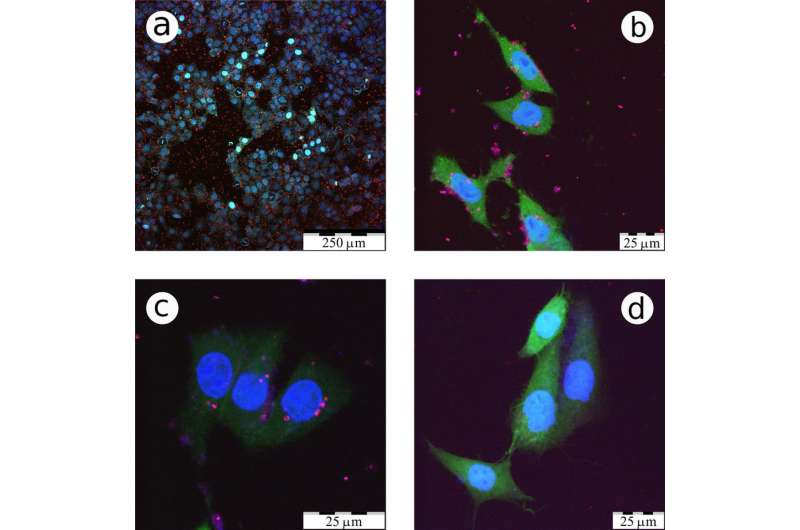Scientists create photoluminscent nanoparticles to highlight cancer cells

A group of Russian and French researchers, with the participation of scientists from the Lomonosov Moscow State University, has synthesized nanoparticles of ultrapure silicon that exhibit efficient photoluminescence, secondary light emission after photoexcitation. These particles easily penetrated into cancer cells for use as luminescent markers in the early diagnosis and treatment of cancer. The study was published in the journal Scientific Reports.
According to co-author Victor Timoshenko, previous attempts in other laboratories were unsuccessful, mainly because the nanoparticles were synthesized by chemical reactions in acid solutions. "The obtained particles were not sufficiently pure," he says. "By-products of the chemical reactions made them toxic. Furthermore, these nanoparticles had a form, which was far from a sphere, and it does not contribute to the appearance of the photoluminescence. These two drawbacks severely restricted their applications."
To address these shortcomings, the researchers used a different method, so-called laser ablation, which ejects atoms from the target with a laser beam, so that the torn atoms form a nanocrystal. The problem was that the atoms torn in this case often did not combine with particles, but with some arbitrary layers, and even if the nanoparticles were obtained, they were not photoluminescent. Either the nanoparticles were too large, or they cooled down too quickly and did not have time to form high-quality nanocrystals. Thus, it was necessary to warm them for a short time to encourage crystallization.
"For that purpose, we decided to use short, high-intensity laser pulses," Professor Timoshenko says. "They not only ejected the silicon atoms from the target, but additionally ionized them. The emitted electrons led to the ionization of helium atoms comprising the atmosphere in which it was occurring. Within nanoseconds, laser plasma formed the conditions that allowed the atoms to sinter into spherical nanocrystals. These beads falling onto the surface aggregated as a fluffy layer, which could subsequently be dispersed in water."
These spherical nanoparticles were just the right size, two to four nanometers in diameter, which provided efficient photoluminescence in which each falling photon was balanced with one ejected. In contrast to nanoparticles obtained by chemical etching, they did not require toxic additives. And most importantly, as demonstrated by biological experiments, they could easily penetrate into the cells. Moreover, the nanospheres penetrated cancer cells much more readily than healthy ones. This is because cancer cells are always ready to divide, and thus absorb everything to produce daughter cells. According to Victor Timoshenko, depending on the type of cells, cancer cells typically absorb nanoparticles 20 to 30 percent more efficiently than healthy ones, which forms a basis for the diagnosis of early-stage cancer.
"Our main achievement was producing the nanoparticles and establishing that they easily penetrate into cancer cells," Victor Timoshenko said. "The problem of the diagnosis is a separate task, which was solved simultaneously by biologists, with our participation. You can, for example, replace the analysis of biopsy, a fairly long and unreliable 'yes-no' test, instead detecting whether or not a nanoparticle penetrated a tissue sample. There are also non-invasive diagnostic methods. The photoluminescent light emitted from the nanoparticles in this case is difficult to use, but they can be activated by other means—for example, ultrasound or radio frequency electromagnetic waves."
The main advantage of the nanoparticles is that they are completely nontoxic and easily excreted. They can also bind to specific substances or biomolecules (e.g., antibodies), allowing doctors to target them into cancer cells and thereby increase the efficiency of diagnosis. According to Victor Timoshenko, in the future these nanoparticles could also bind to drugs that will not only detect cancer, but also conduct local chemotherapy or radiotherapy at the cellular level.
More information: M. B. Gongalsky et al, Laser-synthesized oxide-passivated bright Si quantum dots for bioimaging, Scientific Reports (2016). DOI: 10.1038/srep24732
Journal information: Scientific Reports
Provided by Lomonosov Moscow State University

















